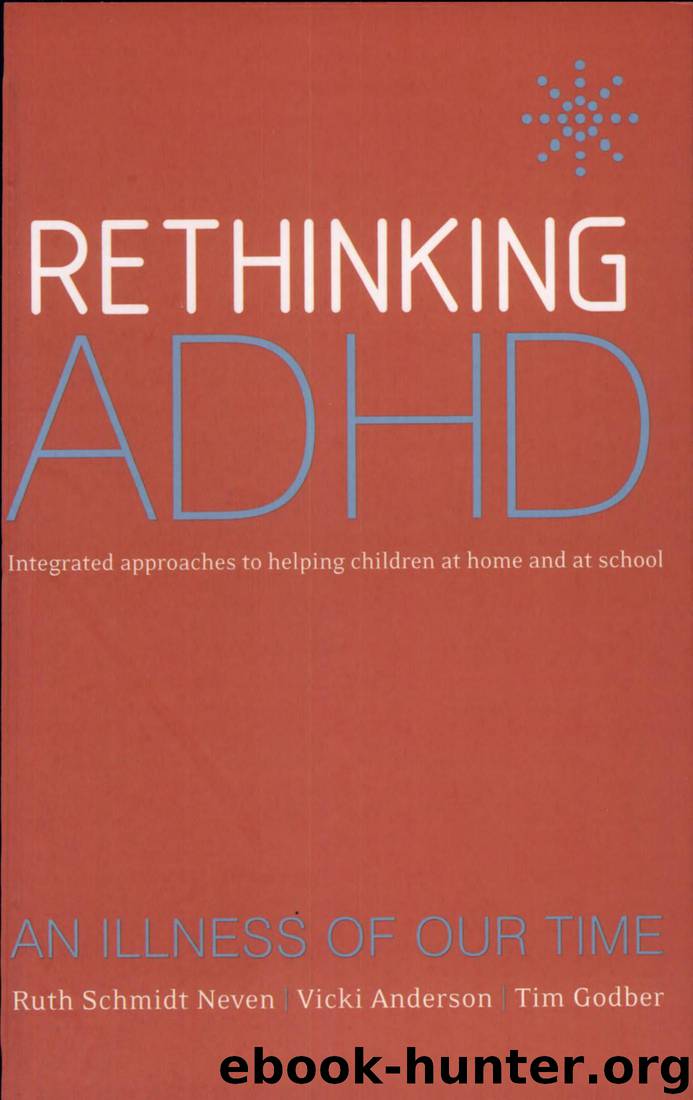Rethinking ADHD: Integrated Approaches to Helping Children at Home and at School by Vicki Anderson & Tim Godber

Author:Vicki Anderson & Tim Godber
Language: eng
Format: mobi
ISBN: 9781865088167
Publisher: Allen & Unwin
Published: 2003-04-01T21:00:00+00:00
a psychodynamic approach
What is the common ground between the neuropsychological perspective and the psychodynamic approach to ADHD? Recent research and clinical studies suggest that the insights of neurobiology and the link with early infantile experience might provide a promising start. These findings lead us to change our focus from viewing ADHD as a distinct syndrome to viewing the condition as the symptomatic outcome of a highly complex interrelationship between the development of brain structure and the actual experience of the child.
Rima Shore (1997) suggests that we need to replace our ‘old thinking’ about the brain as developing in a linear mode with ‘new thinking’ about the brain that indicates that there is a complex interplay between genetic endowment and the experiences we have. These experiences have a significant impact on the ‘architecture of the brain’ that in turn affects the activity of the brain. She points out that by the time children reach the age of three, their brains are twice as active as those of adults. Most significantly, the early interactions of childhood create not only a context for development but ‘directly affect the way the brain is wired’. Of particular significance is the recognition that for infants and young children there are prime times for acquiring different kinds of knowledge and skills.
97
Rethinking ADHD - TEXT PAGES 12/6/02 1:57 PM Page 98
Rethinking ADHD
The concept of self-regulation
Allan Schore (1994) sees the regulation of affect or emotional experience as a cornerstone of this connection as well as the necessary goal or outcome of the maturational process. Schore is optimistic that the
‘phenomenon’ of self-regulation might prove to be a point of convergence for psychology and neuroscience. Schore asserts that self-regulation is an essential organising principle of all living systems. As such, it is one of the few theoretical constructs that are utilised by all scientific disciplines. It is multi-level and multidisciplinary, and can be studied along a number of separate but interrelated dimensions from the molecular level through to the social and cultural level. The concept of self-regulation within the context of a developmental and psychodynamic approach is particularly useful because development itself for the child is characterised by a progression of stages in which there is a close interaction between the child’s capacity to develop self-regulation and their capacity to engage with their environment.
Schore believes that close and positive contact with the caregiver is essential for the infant and young child to achieve regulation of affect through regulation of the developing autonomic nervous system. Here the self-organising capacity of the developing brain, that of the infant and young child, occurs in the context of a relationship with another self and another brain—namely the primary caregiver. The latter acts as an ‘external psychobiological regulator of the experience dependent growth of the infant nervous system’.
These experiences shape the maturation of those structural connections within the brain that are associated with socio-affective functioning.
Siegel (2001) points out that we must take into account the fact that the brain is ‘a complex set of integrated systems that tend to function together’.
Download
This site does not store any files on its server. We only index and link to content provided by other sites. Please contact the content providers to delete copyright contents if any and email us, we'll remove relevant links or contents immediately.
I Capture the Castle by Dodie Smith(2010)
The Heavy by Dara-Lynn Weiss(1787)
Aspergirls by Rudy Simone(1680)
Be Different by John Elder Robison(1622)
Autism's False Prophets by Paul A. Offit(1513)
My Child's Different by Elaine Halligan(1486)
Smart but Scattered—and Stalled by Richard Guare(1475)
101 Tips for the Parents of Boys with Autism by Ken Siri(1458)
What's Making Our Children Sick? by Michelle Perro(1401)
Asperger Syndrome (Autism Spectrum Disorder) and Long-Term Relationships by Ashley Stanford(1393)
ADHD by Mark Selikowitz(1374)
Girlish by Lara Lillibridge(1358)
On Immunity: An Inoculation by Biss Eula(1344)
Nerdy, Shy, and Socially Inappropriate by Cynthia Kim(1325)
An Adult with an Autism Diagnosis by Gillan Drew(1322)
Animal-assisted Interventions for Individuals with Autism by Temple Grandin(1300)
Sarah's Child (Hqn Romance) by Linda Howard(1292)
The Cities by K.A Knight(1284)
Seeing Ezra by Kerry Cohen(1281)
